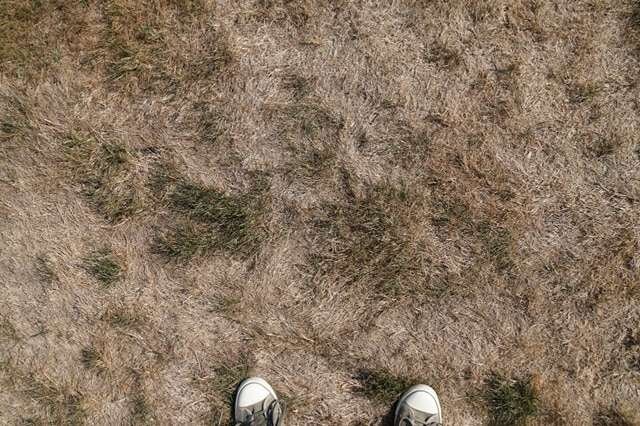Have you noticed those unsightly brown patches that spread across your lawn every summer, leaving you with patches of sparse grass and exposed dirt? You’re not alone – brown patch disease is one of the most common lawn diseases during the hot summer. Caused by the fungus, the brown patch thrives when nighttime temperatures are warm and humidity is high. Left untreated, it can quickly turn half your yard into a barren wasteland!
But don’t despair – with a few basic steps, you can eliminate brown patches and restore your lawn’s lush green carpeting. This guide will walk you through identifying brown patches, selecting the right treatment for your situation, and applying remedies to repair damaged areas and prevent future outbreaks.
What Causes Brown Lawn Patches?
Understanding the causes of brown lawn patches is the first step toward effective prevention and treatment. Factors contributing to this common lawn disease are varied and can include a combination of environmental conditions, lawn care practices, and the type of grass.
Environmental Conditions
Environmental conditions can primarily trigger brown patches in your lawn. The fungus that causes the disease thrives in warm, humid weather, particularly when nighttime temperatures remain above 68°F (20°C). Prolonged periods of wetness, either from rainfall or over-irrigation, also create an ideal environment for spreading the disease.
Lawn Care Practices
Certain lawn care practices can inadvertently encourage the development of brown patches. Over-fertilizing your lawn, especially with high-nitrogen fertilizers, can make your grass more susceptible to this disease. Similarly, infrequent but deep watering of the lawn is more beneficial than frequent shallow watering, as the latter can create ideal conditions for fungal growth.
Grass Type
Finally, the type of grass in your lawn can play a significant role in its susceptibility to brown patch disease. Grasses like St. Augustine, Bermuda, and Kentucky Bluegrass are particularly prone to this disease, especially when under stress from heat or drought. On the other hand, drought-resistant grasses like Tall Fescue are less likely to develop brown patches.
How to Identify Brown Patches?
The first step towards repairing brown patches is identifying them accurately. The symptoms of brown patch disease can vary depending on the type of grass and the severity of the infection. However, some common signs of brown patches include:
- Circular or irregular-shaped patches of brown or yellowed grass
- The affected areas are often sunken, with dark edges and a lighter center
- In severe cases, the patches can merge and cover large areas of the lawn
If you’re unsure whether your lawn has brown patch disease or another issue, you can consult a professional landscaper for confirmation.
Treatment Options:
Once you’ve identified brown patches on your lawn, it’s time to start treating them. The best course of action will depend on the severity of the infection and the type of grass in your lawn. Some common treatment options include:
1. Fungicides
Fungicides are chemical compounds that can kill or inhibit the growth of fungi. They are effective for controlling brown patch disease, but they should be used with caution as they can harm beneficial microorganisms in the soil. Consult a professional before using fungicides, and always follow the instructions on the label.
2. Aerating and Overseeding
If your lawn has large areas of brown patches, aerating and overseeding may help restore it to its former glory. Aeration involves creating holes in the soil to improve air and water circulation. Overseeding, on the other hand, involves planting new grass seeds in the affected areas to fill in bare spots and promote healthy growth.
3. Proper Lawn Care
Preventing brown patches from developing or reoccurring is often a matter of proper lawn care practices. Ensuring your lawn receives adequate nutrients through fertilization, watering deeply but infrequently, and mowing at the correct height can help keep brown patch disease at bay.
Post-Treatment Lawn Maintenance:
After treating brown patches, it’s crucial to maintain your lawn properly to prevent the issue from recurring. Here are some steps you can take for post-treatment lawn care:
1. Regular Monitoring
Keep a close eye on your lawn, especially during the warmer and more humid months. Early detection of brown patches can make treatment more effective and stop the spread of the disease.
2. Correct Mowing Technique
Mow your lawn at the right height for your grass type, as mowing too short can stress your grass and make it more susceptible to diseases. Keep the mower blades sharp to ensure clean cuts and avoid damaging the grass.
3. Balanced Fertilization
Use a balanced fertilizer that provides all the necessary nutrients your lawn needs. Avoid over-fertilization, especially with nitrogen-rich fertilizers, as they can encourage fungal growth.
4. Watering Practices
Water your lawn deeply but infrequently to encourage deep root growth and prevent waterlogged conditions that favor fungal growth. The best time to water your lawn is early morning, allowing the grass to dry off before nighttime.
Conclusion:
Dealing with brown patches in your lawn can be frustrating, but with proper understanding, identification, treatment, and care, you can restore your lawn to its lush, green state. Remember, the key to a healthy lawn is regular maintenance and prompt action at the first sign of trouble. Contact a lawn expert to find out more about treating and preventing brown patches in your lawn.









